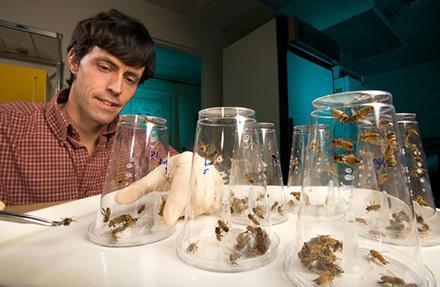By: Kim Kaplan
Jay Evans, research leader of the ARS Bee Research Laboratory in Beltsville, Maryland.
BELTSVILLE, MARYLAND, June 20, 2019—Agricultural Research Service (ARS) scientists have taken the first step towards a weapon against the major honey bee parasite Nosema ceranae.
There is currently no treatment for this parasite.
The scientists found that feeding honey bees a small amount of an interfering RNA compound (RNAi) could disrupt the reproduction of N. cerana by as much as 90 percent in the laboratory study, according to a study recently published in Insect Molecular Biology.
This RNAi compound targets a single N. ceranae gene called Dicer, explained Jay Evans, research leader of the ARS Bee Research Laboratory in Beltsville, Maryland, and regular Bee Culture contributor, who headed the study.
“Dicer is a critical part of Nosema ceranae’s machinery for defeating honey bees’ immune responses to infestation by these parasites. It also encodes an essential protein in N. ceranae’s reproduction. So, it could be a double-barreled, practical route for attacking N. ceranae. Even better, RNAi against Dicer is specific to the parasite and will not interfere with the health of the honey bees,” Evans said.
In earlier studies, the lab had looked at attacking N. ceranea genes that encodes for proteins that make N. ceranae a better parasite such as a polar tube protein that is important in the invasion of bee cells by the parasite.
“But by striking at a single gene that affects N. ceranae reproduction and the ability of this parasite to counter honey bee immunity, I think we may have found an even better—an excellent avenue of attack,” Evans added.
But this is just the first step toward a possible treatment. The researchers need to prove the concept in the field and beekeepers’ apiaries.
Nosema ceranae is widespread problem of honey bees, although the impacts on colony health remain unclear. The best measure of the damage of Nosema comes from Europe where this parasite has been linked to long-term colony declines in Spain.
A chemical treatment had been available, but it was taken off the market due to production challenges.
The Agricultural Research Service is the U.S. Department of Agriculture’s chief scientific in-house research agency. Daily, ARS focuses on solutions to agricultural problems affecting America. Each dollar invested in agricultural research results in $20 of economic impact.
______________________________________________________________________________________________________________________________________
P.S. Have you seen our newest column in Bee Culture? It’s called ALL AROUND THE BEEYARD. Simply put, it’s a page of good ideas sent in by readers to make life in bees faster, simpler, easier, cheaper and better. Good ideas home grown and shared by those who saw a good idea. If you have a good idea you’d like to share, give us a paragraph or two on what it is, and a drawing or photo of what it looks like if that is needed to better share the idea. Send it in an email to Jerry@beeculture.com, with All Around in the subject line. Best of the month wins $100.00. The others get a free 1 year subscription. How cool is that?







